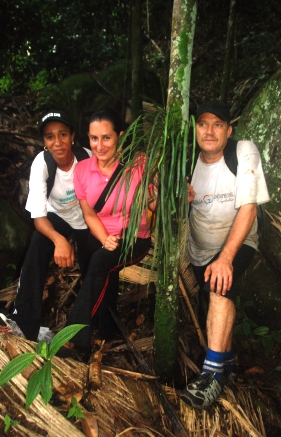Rare plant rediscovered on Silhouette Island |17 December 2012

Such discovery provides great satisfaction and a sense of achievement. This was the feeling of a group of researchers on Silhouette island, where a species of fern, Haplopteris zosterifolia, was rediscovered.
That fern belongs to the family Vittariaceae and had been seen in Seychelles only three times in the old days: first by Pervillé (ca.
1840, on Mahé), then by de l’Isle (ca. 1876, on Mahé, at Mare aux Cochons) and it was last seen by Thomasset (early 1900s, on Mahé).
After more than a century without being contemplated, Haplopteris zosterifolia was rediscovered in a valley of Silhouette.
The rediscovery was made on October 11, 2012 by the KBA (Key Biodiversity Areas) researchers comprising members of the Natural History Museum and different non-governmental organisations (NGOs) – Plant Conservation Action group (PCA), Terrestrial Restoration Action Society of Seychelles (Trass) and the Island Conservation Society (ICS).
Ferns of the family Vittariaceae are mostly recognised by their long ribbon-like leaves (‘vita’ meaning ‘ribbon’ in latin) and by the sores (reproductive parts) disposed in lines along the leaf margins.
The genus Haplopteris is distributed throughout the old world tropics (from Africa to South-East Asia and the Pacific islands). Four species have been recorded in Seychelles, of which another one is still to be rediscovered.
Haplopteris zosterifolia differs from the other species in having long-pendulous leaves, up to 1m long and 1cm wide, with marginal sores (not sub-marginal) and longer creeping rhizome with the leaves well spaced apart.
That fern typically grows as an epiphyte on the endemic ‘Latanye fey’ trunk or on its crown. Its habitat seems restricted to submontane ravine forest in pristine stands or patches. This habitat-type is itself very rare and has been heavily destroyed by human influence, which explains the rarity of the plant.
It is an indigenous species, occurring also in the Mascarenes and eastwards to Polynesia.
During the exploration trip on Silhouette, only two populations were discovered.
After that, we visited the Seychelles National Herbarium with the aim of reviewing the existing specimens of that fern family.
That’s when we made another discovery: that very rare fern had already been collected a few years ago on Curieuse (September 2009) and close to Mare aux Cochons (Mahé, July 2008).
But that earlier discovery remained latent all that time simply because the collected specimen had still to be reviewed.
This emphasises the importance of developing projects to allocate more time for local botanists to review the existing collections of the National Herbarium.
It also emphasises the role of the current PCA’s ‘Herbarium project’ (a SGP-GEF funded project, 2011-2012) which has intensively reorganised the Seychelles National Herbarium, making the specimens more easily accessible for revision.
As a result of our explorations and herbarium studies, Haplopteris zosterifolia is now known from four small populations, which makes it one of the rarest plants of Seychelles.
Its rediscovery and the improved knowledge on its distribution and habitat are important contributions to the understanding of conservation issues in Seychelles, and especially on the role of ravines and valleys as biodiversity microfugia.
Contributed by the KBA experts under the GEF-UNDP Key Biodiversity Area project




